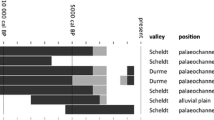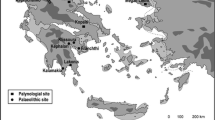Abstract
Four elm declines were found in a pollen diagram from a small lake in northwest Denmark. Matching consecutive radiocarbon dates with the dendro-chronological calibration curve indicated a reservoir effect of 120 years, and dates for the four elm declines were obtained (4530, 4130, 3870, 3410 cal B.C.). The occurrence of apophytes (native plants encouraged by human activities) and increased vegetation diversity during the four elm declines indicates human disturbance. The first and second elm declines coincide with traces of early agriculture in northern Germany. The third and fourth elm declines are contemporary with the transitions to the Early Neolithic and the Middle Neolithic Funnel Beaker Culture in Denmark. The possible influence of outbreaks of elm disease is discussed.
Similar content being viewed by others
References
Aaby B (1983) Forest development, soil genesis and human activity illustrated by pollen and hypha analysis of two neighbouring podzols in Draved Forest, Denmark. Geol Survey Denmark, 2, 114: 1–114
Aaby B (1986) Trees as anthropogenic indicators in regional pollen diagrams from eastern Denmark. In: Behre K-E (ed) Anthropogenic indicators in pollen diagrams. Balkema, Rotterdam, pp 73–93
Aaby B, Digerfeldt G (1986) Sampling techniques for lakes and bogs. In: Berglund BE (ed) Handbook of Holocene palaeoecology and palaeohydrology. Wiley, Chichester, pp 181–194
Andersen SH (1991) Norsminde; A „kökkenmödding“ with Late Mesolithic and Early Neolithic occupation. J Danish Archaeol 8: 13–40
Andersen SH, Johansen E (1992) An Early Neolithic grave at Björnsholm. J Danish Archaeol 9: 38–58
Andersen ST (1961) Vegetation and its environment in Denmark in the Early Weichselian Glacial (Last Glacial). Geol Survey Denmark, 2, 75: 1–175
Andersen ST (1978) Local and regional vegetational development in eastern Denmark in the Holocene. Geol Survey Denmark, Yearbook 1976: 5–27
Andersen ST (1979) Identification of wild grass and cereal pollen. Geol Survey Denmark, Yearbook 1978: 69–92
Andersen ST (1984) Forests at Lövenholm, Djursland, Denmark, at present and in the past. With a contribution by HJB Birks. Kong Danske Videnskab Selsk Biol Skr 24,1
Andersen ST (1991) Natural and cultural landscapes since the ice age shown by pollen analyses from small hollows in a forested area in Denmark. J Danish Archaeol 8: 188–199
Andersen ST (1992a) Pollen spectra from two Early Neolithic lugged jars in the long barrow at Björnsholm, Denmark. J Danish Archaeol 9: 59–63
Andersen ST (1992b) Early and Middle Neolithic agriculture in Denmark: Pollen spectra from soils in burial mounds of the Funnel Beaker Culture. J European Archaeol 1: 153–179
Bakels CC (1992) Research on land clearance during the Early Neolithic in the loess region of The Netherlands, Belgium and Northern France. In: Frenzel B (ed) Evaluation of land surfaces cleared from forests by prehistoric man in Early Neolithic times and the time of migrating Germanic tribes. Paläoklimaforschung 8, Special Issue: ESF Project, European Palaeoclimate and Man 3. Fischer, Stuttgart, pp 47–56
Birks HJB (1986) Late Quaternary biotic changes in terrestrial and lacustrine environments, with particular reference to north-west Europe. In: Berglund BE (ed) Handbook of Holocene palaeoecology and palaeohydrology. Wiley, Chichester, pp 3–65
Birks HJB, Line JM, Persson T (1988) Quantitative estimation of human impact on cultural landscape development. In: Birks HH, Birks HJB, Kaland PE, Moe D (eds) The cultural landscape — past, present and future. Cambridge University Press, Cambridge, pp 229–240
Birks HJB, Line JM (1992) The use of rarefaction analysis for estimating palynological richness from Quaternary pollen-analytical data. Holocene 2: 1–10
Clark JS (1988) Particle motion and the theory of charcoal analysis: Source area, transport, deposition, and sampling. Quat Res 30: 67–80
Fægri K (1994) On the introduction of agriculture in western Norway. Geol Fören Stockholms Förhandl 66: 449–462
Fægri K, Iversen J (1975) Textbook of pollen analysis. 3rd edition. Munksgaard, Copenhagen
Gaillard MJ, Berglund BE, Göransson H, Hjelmroos M, Kolstrup E, Regnéll J (1991) Chronology of the pollen diagrams from the Ystad area. In: Berglund BE (ed) The cultural landscape during 6000 years in southern Sweden — the Ystad Project. Appendix A. Ecological Bulletins (Copenhagen) 41, pp 489–496
Geel B van, Mook WG (1989) High-resolution 14C dating of organic deposits using natural atmospheric 14C variations. Radiocarbon 31: 151–155
Grönlund E, Kivinen L and Simola H (1992) Pollen analytical evidence for Bronze-Age cultivation in eastern Finland. Laborativ Arkeologi 6: 37–42
Göransson H (1987) Neolithic man and the forest environment around Alvastra pile dwelling. Theses and Papers in North-European Archaeology 20. Und University Press, Stockholm
Haas JN, Rasmussen P (1993) Zur Geschichte der Schneitel- und Laubfutterwirtschaft in der Schweiz — eine alte Landwirtschaftpraxis kurz vor dem Aussterben. Diss Bot 195: 469–489
Huntley B, Birks HJB (1983) An atlas of past and present pollen maps for Europe: 0–13000 years ago. Cambridge University Press, Cambridge
Jennbert K (1992) Evaluation of human impact on vegetation and the determination of areas cleared from forests in southern Scandinavia during Late Mesolithic and Neolithic times. In: Frenzel B (ed) Evaluation of land surfaces cleared from forests by prehistoric man in Early Neolithic times and the time of migrating Germanic tribes. Paläoklimaforschung 8, Special Issue: ESF Project, European Palaeoclimate and Man 3. Gustav Fischer Verlag, Stuttgart, pp. 103–114
Johansen J (1978) Outwash of terrestrial soils into Lake Saksunarvatn, Faroe Islands. Geol Survey of Denmark, Yearbook 1977: 31–38
Kalis AJ (1988) Zur Umwelt des frühneolithischen Menschen: Ein Beitrag der Pollenanalyse. Forsch u Ber Ur- Frühgesch Baden-Württemberg 31: 125–138
Kalis AJ, Meurers-Balke J (1988) Wirkungen neolithischer Wirtschaftweisen in Pollendiagrammen. Archäol Inf 11: 39–53
Kalis AJ, Zimmermann A (1988) An integrative model for the use of different landscapes in Linearbandkeramik times. In: Bintliff JL, Davidson DA, Grant EG (eds) Conceptual issues in environmental archaeology. Edinburgh University Press, pp 145–152
Kolstrup E (1988) Late Atlantic and early Subboreal vegetational development at Trundholm, Denmark. J Archaeol Sci 15: 503–513
Küster H (1988) Vom Werden einer Kulturlandschaft. Vegetationsgeschichtliche Studien am Auerberg (Südbayern). VCH, Acta Humaniora, Weinheim
Lanting JN, Bottema S (1991) Aanwijzingen voor ein Pre-Trechterbeker Landnam in het Gietsenveentje, Gem-Gieten (DR.)(Evidence of a pre-funnel beaker landnam in the Gietsenveentje, Gieten community, [in Dutch]). Paleoaktueel 2, Biologisch-Archaeologisch Instituut Groningen: 37–39
Latalowa M (1992) Man and vegetation in the pollen diagrams from Wolin Island (NW Poland). Acta Palaeobot 32:123–249
MacDonald GM, Beukens RP, Kieser WE (1991) Radiocarbon dating of limnic sediments: A comparative analysis and discussion. Ecology 72: 1150–1155
Madsen T (1982) Settlement systems of early agricultural societies in east Jutland: A regional study of change. J Anthropol Archaeol 1: 197–236
Moe D, Rackham O (1992) Pollarding and a possible explanation of the neolithic elmfall. Veget Hist Archaeobot 1: 63–68
Molloy K, O'Connell M (1991) Palaeoecological investigations towards the reconstruction of woodland and land-use history at Lough Sheeauns, Connemara, western Ireland. Rev Palaeobot Palynol 67: 75–113
Moore PD, Webb JA, Collinson ME (1991) Pollen analysis. 2rd edition. Blackwell, London
O'Connell M, Frazer JG, Mitchell G, Readman PW, Doherty TJ, Murray DA (1987): Palaeoecological investigations towards the reconstruction of the post-glacial environment of Lough Doo, County Mayo, Ireland. J Quat Sci 2: 149–164
Odgaard B (1989) Cultural landscape development through 5500 years at Lake Skånsø, northwestern Jutland as reflected in a regional pollen diagram. J Danish Archaeol 8: 200–210
Odgaard B (1992) Pollen diversity as a reflection of past human impact on vegetation. 8th International Palynological Congress, Aix-en-Provence, Programme and Abstract, Aix-en-Provence, p. 108
Olsson IU (1986) Radiocarbon dating. In: Berglund B (ed) Handbook of Holocene palaeoecology and palaeohydrology. Wiley, Chichester, pp. 275–297
Patterson WA, Edwards KJ, Maguire DJ (1987) Microscopic charcoal as a fossil indicator of fire. Quat Sci Rev 6: 3–23
Pearson GW (1986) Precise calendrical dating of known growth-period samples using a ‘curve-fitting’ technique. Radiocarbon 28: 292–299
Pearson GW, Becker B, Qua F (1993) High-precision measurements of German and Irish oaks to show the natural 14C variations from 7890–5000 BC. Radiocarbon 35: 93–104
Peglar S (1993) The mid-Holocene Ulmus decline at Diss Mere, Norfolk, UK: a year-by-year pollen stratigraphy from annual laminations. Holocene 3: 1–13
Pott R (1992) The impact of Early Neolithic agriculture on vegetation in Northwestern Germany. In: Frenzel B (ed) Evaluation of land surfaces cleared from forests by prehistoric man in Early Neolithic times and the time of migrating Germanic tribes. Paläoklimaforschung 8, Special Issue: ESF Project, European Palaeoclimate and Man 3. Fischer, Stuttgart, pp. 57–72
Rackham O (1980) Ancient woodland, its history, vegetation and uses in England. Arnold, London
Rasmussen P (1989) Leaf foddering in the earliest Neolithic agriculture. Evidence from Switzerland and Denmark. Acta Archaeol 60: 71–86
Regnéll J (1992) Preparing pollen concentrates for AMS dating — a methodological study from a hard-water lake in southern Sweden. Boreas 21: 373–377
Rowley-Conwy P (1982) Forest grazing and clearance in temperate Europe with special reference to Denmark: An archaeological view. In: Limbrey S, Bell M (eds) Archaeological aspects of woodland ecology, Br Archaeol Rep Int Ser 146, pp 199–215
Stuiver M, Pearson GW (1993) High-precision bidecadal calibration of the radiocarbon time scale, AD 1950–500 BC and 2500–6000 BC. Radiocarbon 35: 1–24
Stuiver M, Reimer PJ (1993) Extended 14C data base and revised CALIB 3.0 14C age calibration program. Radiocarbon 35: 215–230
Tolonen K (1986) Charred particle analysis. In: Berglund B (ed) Handbook of Holocene palaeoecology and palaeohydrology. Wiley, Chichester, pp 485–496
Troels-Smith J (1953) Ertebøllekultur — Bondekultur (Ertebølle Culture — peasant culture, [in Danish]). Aarbøger nordisk Oldkynd Hist 1953: 5–62
Troels-Smith J (1984) Stall-feeding and field-manuring in Switzerland about 6000 years ago. Tools and Tillage 5: 13–25
Whittington G, Edwards K, Cundill PR (1991) Palaeoecological investigations of multiple elm declines at a site in north Fife, Scotland. J Biogeog 18: 71–87
Author information
Authors and Affiliations
Rights and permissions
About this article
Cite this article
Andersen, S.T., Rasmussen, K.L. Radiocarbon wiggle-dating of elm declines in northwest Denmark and their significance. Veget Hist Archaebot 2, 125–135 (1993). https://doi.org/10.1007/BF00198583
Received:
Accepted:
Issue Date:
DOI: https://doi.org/10.1007/BF00198583




